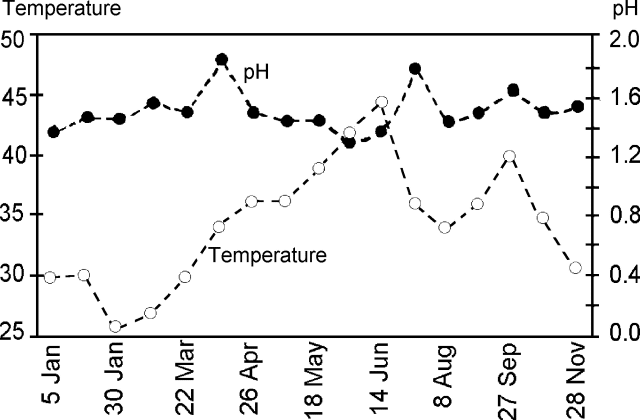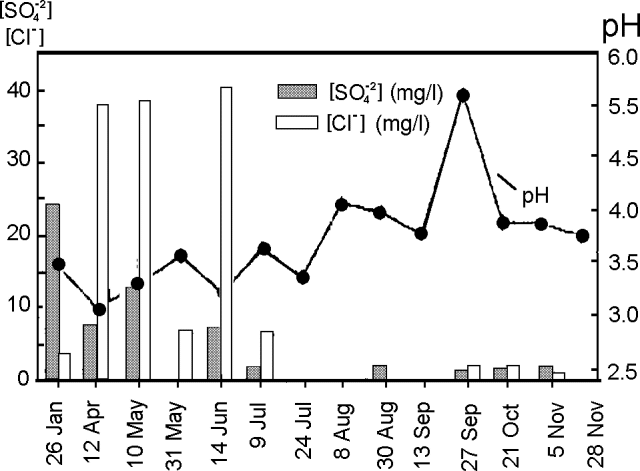Report on Poas (Costa Rica) — December 1996
Bulletin of the Global Volcanism Network, vol. 21, no. 12 (December 1996)
Managing Editor: Richard Wunderman.
Poas (Costa Rica) Fumarolic columns rise 500 m above the crater floor
Please cite this report as:
Global Volcanism Program, 1996. Report on Poas (Costa Rica) (Wunderman, R., ed.). Bulletin of the Global Volcanism Network, 21:12. Smithsonian Institution. https://doi.org/10.5479/si.GVP.BGVN199612-345040
Poas
Costa Rica
10.2°N, 84.233°W; summit elev. 2697 m
All times are local (unless otherwise noted)
During the four-month interval of September-December 1996 OVSCICORI-UNA reported the following N crater lake temperatures: 40, 35, 31, and 29°C, respectively. There were also fluctuations in the N crater lake's surface height. Defining a lake surface height increase with respect to the height in August as positive (+), during the four-month interval the progressive shifts were as follows: +13 cm, -54 cm, -31 cm, and +144 cm. Figures 62 and 63 show temperature and pH for the N crater lake and some chemical data for rainfall during the first eleven months of 1996.
 |
Figure 62. The pH and temperature of the N crater lake at Poás. Data points show discrete values taken at the date shown. Courtesy of OVSICORI-UNA. |
Also during September-October, the accessible fumaroles on the pyroclastic cone maintained a maximum temperature of 93-94°C. Gas columns in the interval rose 500 m above the crater floor.
The number of low-frequency Poás earthquakes registered as follows: 2,351 (September), 2,043 (October), 1,704 (November, adjusted because of 14 days without data). December earthquakes have not yet been reported.
September contained the largest number of earthquakes recorded in any month in 1996. Low-frequency tremor, not seen since May, appeared for ~8 hours in September, also the most seen up to that point in 1996. Continuing the trend, tremor occurred for 28 hours during October. No tremor was recorded in November. For comparison, tremor had reached over 300 hours in December 1995.
Deformation during August and September 1996 was very low. Two lines in the sector S of the crater contracted by an average of ~5 mm (2-3 ppm), a shift considered insignificant. Although electronic tilt measurements were absent for August-September, two leveling lines along the crater's S border have lacked significant tilt since 1995.
Geological Summary. The broad vegetated edifice of Poás, one of the most active volcanoes of Costa Rica, contains three craters along a N-S line. The frequently visited multi-hued summit crater lakes of the basaltic-to-dacitic volcano are easily accessible by vehicle from the nearby capital city of San José. A N-S-trending fissure cutting the complex stratovolcano extends to the lower N flank, where it has produced the Congo stratovolcano and several lake-filled maars. The southernmost of the two summit crater lakes, Botos, last erupted about 7,500 years ago. The more prominent geothermally heated northern lake, Laguna Caliente, is one of the world's most acidic natural lakes, with a pH of near zero. It has been the site of frequent phreatic and phreatomagmatic eruptions since an eruption was reported in 1828. Eruptions often include geyser-like ejections of crater-lake water.
Information Contacts: E. Fernández, E. Duarte, V. Barboza, R. Van der Laat, E. Hernandez, M. Martinez, and R. Sáenz, Observatorio Vulcanológico y Sismológico de Costa Rica, Universidad Nacional (OVSICORI-UNA).


